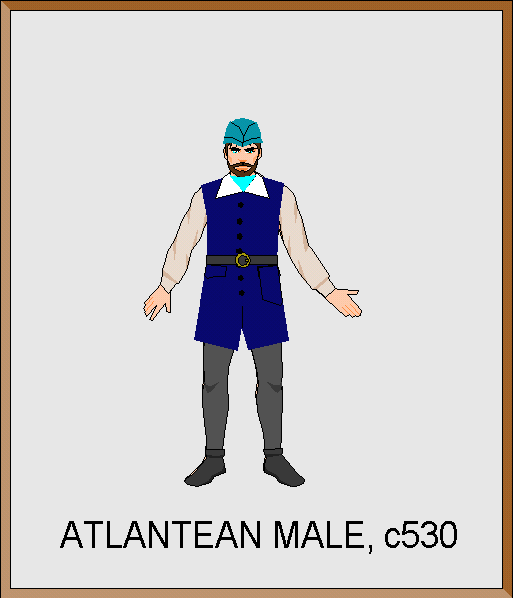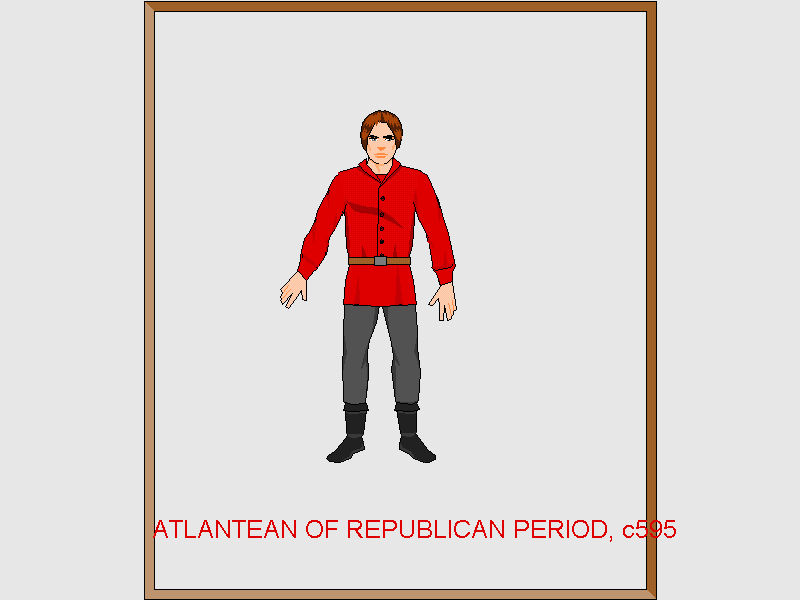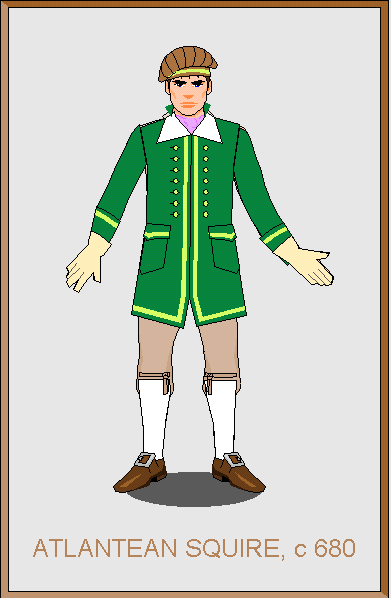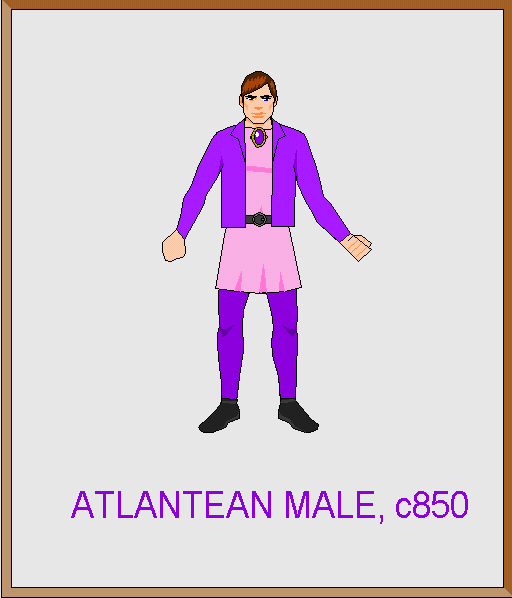A brief history of Atlantean costume
The description below of Atlantean dress and its history is taken
from a popular guide-book written by the curator of the Museum of
Costume around 760 to 765. Museums had existed in the Empire since
the first one was set up in Cennatlantis in 566 by Meison I. This
was largely a collection of artifacts glorifying the Emperors of the
Second Empire, and was not open to the general public. One or two
small towns set up similar exhibitions soon after, and under the
Republic these, and additional, museums were thrown open to the
population at large. Again, though, these establishments were very
tendentious, and were full of propaganda extolling the Republic.
They were closed down after the triumph of the Imperialists, but
after 660, the latter reopened a big national museum in
Cennatlantis. However the future of museums was really laid by
smaller towns at the end of the seventh century. Many of these
places opened what were really local history centres, filled with
documents and objects relating to the history of the communities,
and allowed entry by all local people. These centres were initially
funded by the local councils, but after 720, private museums
appeared, with higher entrance charges. At the same time, the State
set up a much grander museum of all Atlantean history in
Cennatlantis in the 730s.
After 750, the notion of museums really took off, and every town
vied with each other to establish museums of local interest. Many of
these were privately owned, and museums of costume, that is, of
displays of preserved dress from historical times, started to
appear. If costumes of older periods were no longer extant, drawings
were used, and occasionally specially made copies. But it was in
Atlantis that one man had the idea of opening a really national
history of costume, stocking it with examples of dress, real and
copies, on dummies, and with explanatory guides. This was Iairos
Nixalen, and parts of his brief guide to the Atlantean museum are
reproduced below. It will be noted that by and large, only male
dress is dealt with; this changed to include women in the later
years of the Fifth Empire. Later on, too, this, and similar museums,
developed further, keeping up-to-date with modern costume, and using
live actors to walk around wearing costume of the past.
We know next to nothing of the costume of our distant ancestors,
before the Empire of Atlantis was founded, and can guess at what
they wore, only by the comments of writers of the First Empire. For
this reason, we have made no attempt to reproduce the dress of this
time in our museum, other than by drawings. These show you men with
loose shirts and jackets with trousers tucked into boots. The dress
of Atlanteans of the First Empire becomes gradually clearer as we
move towards the full light of the Second Empire. Our reproductions
of costume from the years between 200 and 300 are partly guesswork,
but we now have also a few drawings to base them on. You will see
that the loose shirts, usually of grey or white, are now placed
within a belt, and covered with a shorter jacket and sometimes a
cloak. Trousers are increasingly worn with gaiters, which seemed to
have spread from the lower to the upper classes over the years.
Hats, which were earlier only worn by workers engaged in outdoor
work, are now worn more often by the more leisured classes as well.
At all times Atlanteans had to wear a clear sign of the Class to
which they belonged. By the middle of the third century, this was a
broad strap, which stretched across the upper body, over the area of
the heart, from top left to the right of the waist. Design and
colour of the stripe represented the exact Class. Such marks were
worn by all Classes and both sexes, from the age of 14 upwards. In
the earlier third century, most men were clean-shaven, albeit with
longer hair, although the upper classes and officers in the army
often sported beards and long moustaches, as we can see from the
surviving images from the Helvran War. By the time of the Family
Wars and after, in the next century, facial hair had spread to all
classes. This time, the lower classes often had straggly beards,
while the elite had neat beards, moustaches and quite short hair.
Gradually the fashion for beards died out, as the fourth century
wore on, and by the time of the great Atlaniphon, most fashionable
men were clean-shaven. Moustaches remained in fashion for a while in
some cases, and both Atlaniphon I and II wore them.

After 300, jackets turned into jerkins, and trousers, or sometimes
breeches, were gaitered up to the knees. This costume then developed
into the standard wear of the First Empire in its greatest period,
up until about 480. Men wore a woollen tunic, which extended some
distance below the waist, over the top of trousers with gaiters or
woollen socks, which reached about halfway up the leg towards the
knee. The tunic was always worn under an elaborate belt, which
became almost a symbol of Atlantis.
As the 400s passed, the tunic grew longer and longer, half-way
down the thighs, while gaiters and shoes were replaced by longer
gaiters and boots. A cloak would be worn in cold weather. Hats were
rare in the earlier part of the century, but became more common
later, being oval and domed. Colours of tunics were pale, usually
white, cream or yellow, while trousers and cloak were of a darker
hue, normally green or blue. Straps representing the six Classes
continued to be worn, though after Class distinctions of position
were officially abolished in 422, these straps gradually became more
and more decorative.
The classical military costume of this period consisted of a
tallish oval hat, made of stiff material; a thick tunic, belted,
which extended half-way down the leg towards the knees, and was of
the standard Second Empire colour, yellow or orange. A cloak was
worn, usually dark in colour, while the legs had tight trousers with
shoes, or later, boots. Haversacks were worn, with the crossbow over
one shoulder, and the quiver of arrows at the waist. Leather breast
armour was worn above the waist, with a notable orange boss placed
over the heart. Later on in the 500s, infantry wore more armour to
protect itself against the stronger firepower it now had to face.
This took the form of metal breast armour, and similar protection
for the arms, groin and upper legs.

Later on in the Second Empire, as the age
deteriorated from a golden to a silver one, men’s costume and
appearance changed, also for the worse, in my opinion. By 500,
influenced by the unconventionality of the new Romantic Movement, it
became fashionable to grow the hair longer, and to sport beards. At
the same time, dress became more elaborate and colourful, as our
museum examples show. The tunic, which previously had been either
white, beige or a light yellow (the symbolic colour of the Second
Empire), became virtually a coat, knee-length or longer, in a
variety of mostly dark colours – usually red or green -, and with
some decorations. It fastened with buttons; the traditional cloak
was unfortunately no longer worn. The Atlantean belt remained, but
was worn underneath after the mid-500s. The Class stripe also
continued to be worn; though its wearing was still enforced by law,
it could be of any shape or style, and could be of more than one
colour. Beneath the coat was a thin, short shirt, often brightly
coloured. Legs were covered in tight trousers, often blue or black;
and shoes in due course superseded boots again. Hats were now always
worn.
At the end of the Second Empire, as Romanticism waned, and the
Country became more militarised, a plainer, less colourful and more
military style became popular. This involved plain, thigh-length
coats, and leather top-boots over trousers. Beards went out of
fashion, and were initially replaced by moustaches, which matched
shorter hairstyles. Military dress developed along the same lines,
and it can be difficult to tell civilians and soldiers apart in the
early Imperialist period before and around 600.

The
Revolution marked a sea-change in costume, at first more obviously
in the dress of the Republicans. As a reaction against aristocracy
and privilege, Republicans favoured styles of dress which,
originally, were more like those worn by the common man. This meant
simpler and looser dress, and most notably an open neck, as worn
hitherto by working men: the upper classes had always worn a
high-necked shirt. Baggy shirts were worn over baggy trousers, with
no "upper-class style" tailoring, and no belt, above all.
The trousers were initially worn straight down to the shoes, without
boots or gaiters; later, however, boots were worn over them in the
army, and this spread back to civilian use. Hats were also abandoned
as being too closely associated with the old Empire. Red or pink was
a favourite colour of the Revolutionaries, and Republican soldiers
were distinguished by their bright red shirts and loose, informal
clothing. Hair was loose and long, with sideboards, but not usually
with any other facial hair.
This style of dress was ridiculed by the Imperialists, but in
fact their own costume gradually moved towards the same style. They
too adopted a partially open neck after 600, but kept to a more
tightly tailored and longer topcoat. Both they and the Republicans
abandoned all body armour. Beneath the coat, they wore the
traditional tunic with belt, and trousers tucked into high
top-boots. Hats too became optional for a while. Hair became
shaggier for a while, though after about 610, a short, military
style came into favour. Moustaches continued to be worn until about
620, then the clean-shaven look came into fashion, which was to
prevail right through until the end of the Third Empire. The most
significant change for the Imperialists after 615 was the gradual
adoption of breeches, rather than trousers. This was due to military
influence, and also, in the first instance, the practice of the
country Squires who were now taking over the Army, and would shortly
take over the Empire. With the introduction of breeches, the
traditional showy Atlantean belt became merely functional, to hold
up the breeches. Imperialist military uniform remained very similar
to civilian dress at this time, being essentially dark brown, with
much leather.

After
the fall of the Republic, a style of dress came into being, which
lasted throughout the third Empire, and which, to us, seems to befit
it exactly. It is still a recent period, and we have many examples
in the museum – indeed many of us have grandparents who have never
abandoned this mode of dress! There was a considerable difference
between the costume worn by Squires, and that of the lower Classes.
However, certain rules were laid down by Ruthopheax, which all
Classes had to obey. He insisted that red, the colour of the
Republicans, should never again be worn. Also, the dress of the new
elite of landowning Squires, specifically breeches and stockings or
gaiters, should be worn in lieu of trousers or tight-fitting hose.
Men of the Squire Classes were generally clean-shaven, with
medium-length hair, and always wore large, flat hats. They wore a
dark-brown or green coat –virtually a jacket after the 720s -,
over a white or faun shirt with a brightly coloured cravat, and
sometimes a waistcoat. The cravat had superseded the open neck by
the 640s. The shirt was usually heavily decorated or embroidered,
while the waistcoat, if worn, became a pullover after the 730s.
Breeches were always worn, above the knee, with stockings and shoes,
though riders and soldiers usually wore boots instead. The lower
classes wore somewhat simplified versions of this costume…
The costume of the Army was particularly striking at this time,
developing as a result of deliberate decisions by Ruthopheax, who
wanted to distinguish the Atlantean Army from that of all other
nations. While essentially similar to that of upper-class civilians
– tailored coat over shirt and neckerchief, plus breeches and
shoes or boots, the colours were variations of white, gold and
brown. The exact pattern and ornamentation varied amongst the units
of the army, and obviously the officers had the most elaborate
uniforms. Generally speaking, jackets were white or beige,
embroidered with gold patterns, shirts were white or cream with more
gold or blue decoration for officers, breeches were dark – brown,
or, later, blue or grey -, and stockings were faun or dark grey.
Towards the end of this period, that is to say, after about 710
or 720, civilian dress became simpler and less elaborate, while at
the same time, the colour-range worn became much greater. The
prevalence of brown and green, symbolic of the Third Empire, gave
way to grey, blue, green and even red. In the Army, a growing
awareness of the need for camouflage against the new muskets and
rifles coming into use, led to the abandonment of the colourful and
bright uniforms of earlier times, in favour of more practical, if
duller hues, predominantly blue and grey. This change took place in
several stages, firstly amongst the Frontier Armies, and later for
the Security Forces. Officers were the last to lose their elaborate
white, gold and brown dress, at the start of the Great Continental
War…
As we reach our own time, there has been another costume
revolution, which coincided with the fall of the Third Empire.
Breeches, gaiters, hats and cravats have all been unceremoniously
ousted. Instead, the dress of the lower Classes, which was already
coming into more general use after the 730s, has been adopted by the
whole of society, partly as an expression of revolt against the
Third Empire elite, which was overthrown in 750. The old-fashioned
fitted coat has gone as part of everyday wear; it has been replaced
in cold weather only by a long, loose coat. For normal wear,
trousers are now universally worn, with shoes, in place of the
upper-class breeches and long socks. On top, the showy waistcoat of
olden days has remained, but now in one colour, and usually worn
open, over a shirt buttoned up to the neck. Very recently, the
woollen pullover, which had come into fashion before the Continental
War for all except the highest Classes, seems to be also rising in
popularity. Hair has become longer, but most people are still
clean-shaven.
The Army has remained in the duller colours of blue and grey, which
were adopted before the War. Needless to say, the coat, breeches and
socks, which were worn before and during the first part of the War,
have vanished completely. Already after 745-746, the coat was
shortened to a tighter-fitting, waist-length sort of tunic, while
tighter trousers in thick socks were issued in place of the breeches
and socks of the first years of the War. Medium-length boots were
worn on the feet. As early as 732, a tighter, bonnet-like cap was
issued in place of the larger hats of earlier years. What
the future holds for fashion is difficult to foresee, but I think
dress will become increasingly free, colourful and outrageous…
The author obviously finishes his chronicle in the
760s, but his predictions for the future were quite accurate.
Costume for the rest of the century did become more outrageous, and
it actually became fashionable after the 780s for men to wear women’s
dresses, and vice versa occasionally. Hair became longer, and a
vogue for facial hair, such as sideboards, moustaches and beards
developed after the 780s.

In the Army, uniforms remained similar to
those of the latter stages of the Great Continental War, albeit with
trousers rather than gaiters or socks, ankle-high boots instead of
mid-calf-length ones, and shorter jackets. Also leather helmets were
tentatively replaced by metal helmets of a sort not seen since the
First Empire, as a result of experiences fighting Rabarran artillery
in the 790s. Chest-armour was also reintroduced at this time.
The Tyrants hated the extreme civilian costumes of this era,
and favoured military-style dress – their adherents, civilian and
military, wore black one-piece overalls, emblazoned with the Tyrants’
adopted thunderbolt insignia, and with boots and close-fitting hats
(steel helmets and body-armour in the Frontier Army). The general
population also adopted overall-style dress, with tight trousers.
Fierce moustaches with longish hair became the order of the day.
For the duration of the Fifth Empire, fashion reverted at
first to "traditional" baggy shirts, belts and loose
trousers, with jackets and sometimes thigh-length coats. However,
the differences between this era and the Second Empire were very
marked, because of the use of a greater variety of materials,
subtler and mixed colours, and all sorts of small tailoring effects.
Moreover, for the first time, most women wore a similar outfit to
men. Later, from the 850s onwards, as the grip of conformism
lessened, costume became completely eclectic, and people wore styles
from every era of past Atlantean history, according to the whim of
fashion at that moment. At times, earlier styles of other nations
were tried out, altered here and there to suit contemporary taste.
Once the Final Wars had begun, after 870, costume sobered down, and
became more like the styles of the 830s and 840s, or, as time
passed, facsimiles of the military dress worn by the Army.
Fashion in men’s hair varied, but was initially medium-long
with sideboards. Later most were clean-shaven, though later on a
fashion for straggly beards arose, both amongst ascetic philosophers
and religious people, as well as the hedonists of the 860s and the
Emperor Gailonex himself, in his later years. This mostly died out
again in the Final Wars. The Emperor and Court, which during the
Fourth Empire, had dressed very plainly, adopted much more formal
and ceremonial dress after the 830s, based on the styles of the
First and Second Empires. The favourite colour was mauve, which
became the "standard" colour of the Fifth Empire. This was
not a traditional Atlantean colour, in any way – green and yellow
were -, but was borrowed from the ceremonial costumes of the
Helvrans and some Chalcran states of the First Empire period.
The Army reverted to a modified Fourth Empire uniform,
retaining metal helmets and body-armour at first, though most of the
latter was done away with after the experience of the great Northern
War, which showed that it had little effect. Colour changed to a
dull green as camouflage.